2007 FIAT SEDICI lights
[x] Cancel search: lightsPage 167 of 266
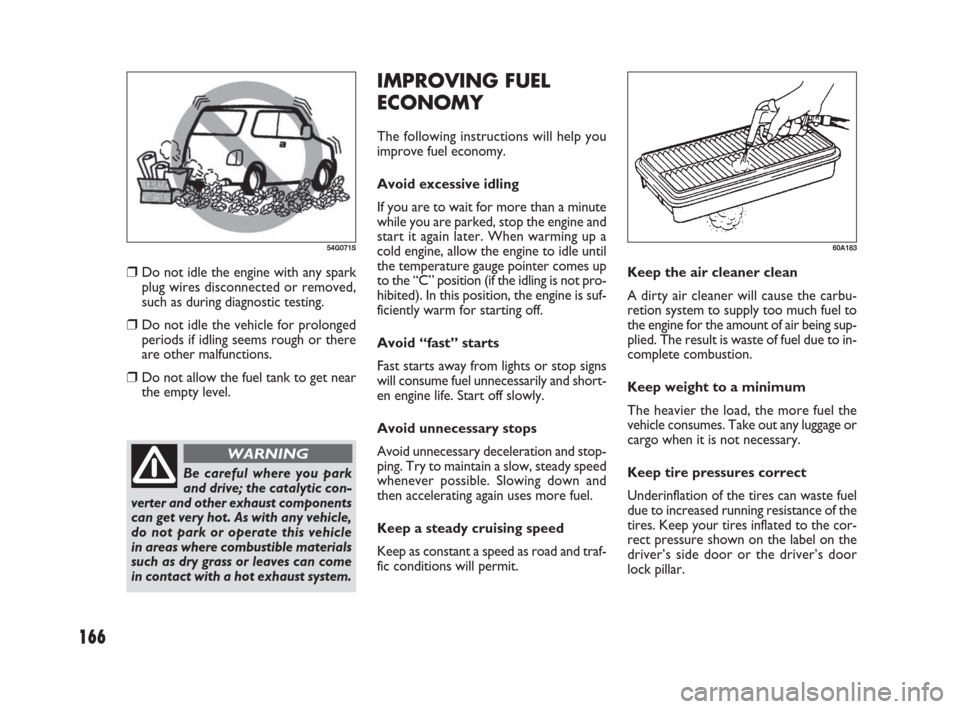
166
IMPROVING FUEL
ECONOMY
The following instructions will help you
improve fuel economy.
Avoid excessive idling
If you are to wait for more than a minute
while you are parked, stop the engine and
start it again later. When warming up a
cold engine, allow the engine to idle until
the temperature gauge pointer comes up
to the “C” position (if the idling is not pro-
hibited). In this position, the engine is suf-
ficiently warm for starting off.
Avoid “fast” starts
Fast starts away from lights or stop signs
will consume fuel unnecessarily and short-
en engine life. Start off slowly.
Avoid unnecessary stops
Avoid unnecessary deceleration and stop-
ping. Try to maintain a slow, steady speed
whenever possible. Slowing down and
then accelerating again uses more fuel.
Keep a steady cruising speed
Keep as constant a speed as road and traf-
fic conditions will permit.Keep the air cleaner clean
A dirty air cleaner will cause the carbu-
retion system to supply too much fuel to
the engine for the amount of air being sup-
plied. The result is waste of fuel due to in-
complete combustion.
Keep weight to a minimum
The heavier the load, the more fuel the
vehicle consumes. Take out any luggage or
cargo when it is not necessary.
Keep tire pressures correct
Underinflation of the tires can waste fuel
due to increased running resistance of the
tires. Keep your tires inflated to the cor-
rect pressure shown on the label on the
driver’s side door or the driver’s door
lock pillar.
60A183
❒Do not idle the engine with any spark
plug wires disconnected or removed,
such as during diagnostic testing.
❒Do not idle the vehicle for prolonged
periods if idling seems rough or there
are other malfunctions.
❒Do not allow the fuel tank to get near
the empty level.
54G071S
Be careful where you park
and drive; the catalytic con-
verter and other exhaust components
can get very hot. As with any vehicle,
do not park or operate this vehicle
in areas where combustible materials
such as dry grass or leaves can come
in contact with a hot exhaust system.
WARNING
149-166 Fiat16 New GB 27-11-2007 11:27 Pagina 166
Page 174 of 266
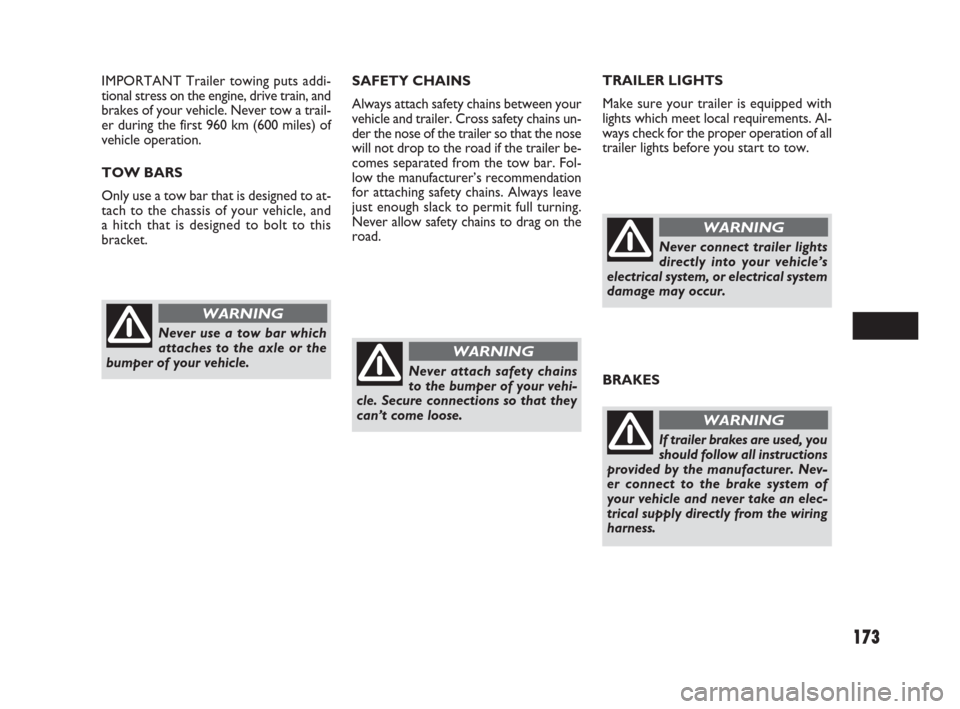
Never use a tow bar which
attaches to the axle or the
bumper of your vehicle.
WARNING
Never attach safety chains
to the bumper of your vehi-
cle. Secure connections so that they
can’t come loose.
WARNING
Never connect trailer lights
directly into your vehicle’s
electrical system, or electrical system
damage may occur.
WARNING
BRAKES
If trailer brakes are used, you
should follow all instructions
provided by the manufacturer. Nev-
er connect to the brake system of
your vehicle and never take an elec-
trical supply directly from the wiring
harness.
WARNING
173
SAFETY CHAINS
Always attach safety chains between your
vehicle and trailer. Cross safety chains un-
der the nose of the trailer so that the nose
will not drop to the road if the trailer be-
comes separated from the tow bar. Fol-
low the manufacturer’s recommendation
for attaching safety chains. Always leave
just enough slack to permit full turning.
Never allow safety chains to drag on the
road.TRAILER LIGHTS
Make sure your trailer is equipped with
lights which meet local requirements. Al-
ways check for the proper operation of all
trailer lights before you start to tow. IMPORTANT Trailer towing puts addi-
tional stress on the engine, drive train, and
brakes of your vehicle. Never tow a trail-
er during the first 960 km (600 miles) of
vehicle operation.
TOW BARS
Only use a tow bar that is designed to at-
tach to the chassis of your vehicle, and
a hitch that is designed to bolt to this
bracket.
171-180 Fiat16 New GB 27-11-2007 11:29 Pagina 173
Page 176 of 266
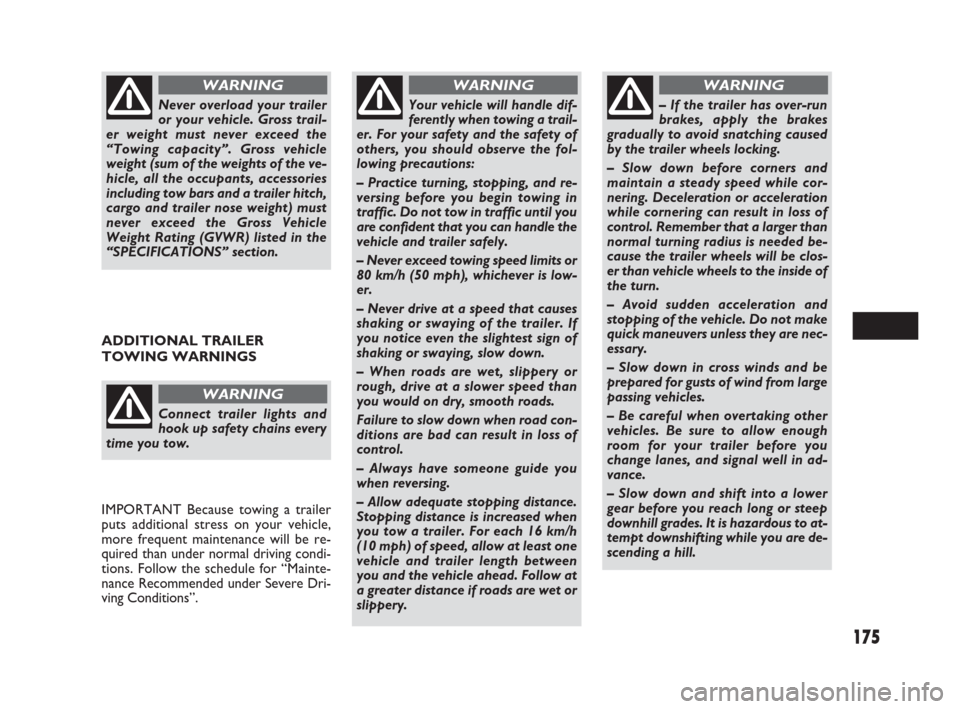
175
ADDITIONAL TRAILER
TOWING WARNINGS
Never overload your trailer
or your vehicle. Gross trail-
er weight must never exceed the
“Towing capacity”. Gross vehicle
weight (sum of the weights of the ve-
hicle, all the occupants, accessories
including tow bars and a trailer hitch,
cargo and trailer nose weight) must
never exceed the Gross Vehicle
Weight Rating (GVWR) listed in the
“SPECIFICATIONS” section.
WARNING
Connect trailer lights and
hook up safety chains every
time you tow.
WARNING
IMPORTANT Because towing a trailer
puts additional stress on your vehicle,
more frequent maintenance will be re-
quired than under normal driving condi-
tions. Follow the schedule for “Mainte-
nance Recommended under Severe Dri-
ving Conditions”.
Your vehicle will handle dif-
ferently when towing a trail-
er. For your safety and the safety of
others, you should observe the fol-
lowing precautions:
– Practice turning, stopping, and re-
versing before you begin towing in
traffic. Do not tow in traffic until you
are confident that you can handle the
vehicle and trailer safely.
– Never exceed towing speed limits or
80 km/h (50 mph), whichever is low-
er.
– Never drive at a speed that causes
shaking or swaying of the trailer. If
you notice even the slightest sign of
shaking or swaying, slow down.
– When roads are wet, slippery or
rough, drive at a slower speed than
you would on dry, smooth roads.
Failure to slow down when road con-
ditions are bad can result in loss of
control.
– Always have someone guide you
when reversing.
– Allow adequate stopping distance.
Stopping distance is increased when
you tow a trailer. For each 16 km/h
(10 mph) of speed, allow at least one
vehicle and trailer length between
you and the vehicle ahead. Follow at
a greater distance if roads are wet or
slippery.
WARNING
– If the trailer has over-run
brakes, apply the brakes
gradually to avoid snatching caused
by the trailer wheels locking.
– Slow down before corners and
maintain a steady speed while cor-
nering. Deceleration or acceleration
while cornering can result in loss of
control. Remember that a larger than
normal turning radius is needed be-
cause the trailer wheels will be clos-
er than vehicle wheels to the inside of
the turn.
– Avoid sudden acceleration and
stopping of the vehicle. Do not make
quick maneuvers unless they are nec-
essary.
– Slow down in cross winds and be
prepared for gusts of wind from large
passing vehicles.
– Be careful when overtaking other
vehicles. Be sure to allow enough
room for your trailer before you
change lanes, and signal well in ad-
vance.
– Slow down and shift into a lower
gear before you reach long or steep
downhill grades. It is hazardous to at-
tempt downshifting while you are de-
scending a hill.
WARNING
171-180 Fiat16 New GB 27-11-2007 11:29 Pagina 175
Page 185 of 266

184
15 30 45 60 75 90 105 120 135 150 165 180
●●●●●●●●●●●●
●●●●●●●●●●●●
●●●●●●●●●●●●
●●●●●●●●●●●●
●●●●●●●●●●●●
●● ●●●●
●●●●●●●●●●●●
●●●●●●●●●●●●
●●
●●
●●●●●●●●●●●●
●● ●●●●
SERVICE SCHEDULE PETROL VERSIONS
Service coupons shall be carried out every 15,000 km
Thousands of km
Check tyre conditions/wear and adjust pressure if required
Check electric system operation headlights,
direction indicators, hazard lights, passenger compartment/
boot light, instrument panel warning lights, etc.)
Check windscreen wiper operation, adjust nozzles if required
Check windscreen blade position/wear
Check front disk brake pad wear conditions and brake
pad wear indicator operation
Check rear disk brake pad or shoes conditions and wear
Sight inspect conditions and integrity of: bodywork and
underbody protection, pipes (exhaust, fuel, brakes),
rubber parts (boots, sleeves, bushes, etc.), brake and
fuel system hoses, axles and axle shafts
Top up fluids (engine coolant, brakes, clutch, battery,
windscreen washer, etc.)
Sight inspect accessory drive belt conditions
Check antievaporation system
Check and adjust handbrake lever stroke, if required
Check and adjust tappet clearance, if required
181-224 Fiat16 New GB 27-11-2007 11:29 Pagina 184
Page 187 of 266
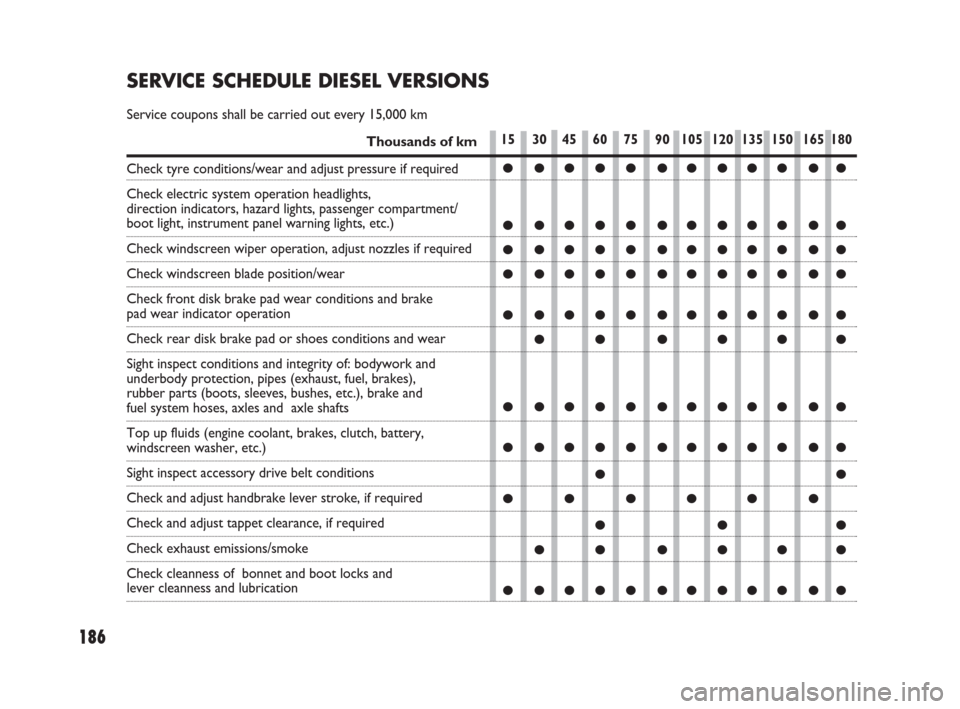
186
15 30 45 60 75 90 105 120 135 150 165 180
●●●●●●●●●●●●
●●●●●●●●●●●●
●●●●●●●●●●●●
●●●●●●●●●●●●
●●●●●●●●●●●●
●● ●●●●
●●●●●●●●●●●●
●●●●●●●●●●●●
●●
●●●●●●
●●●
●● ●●●●
●●●●●●●●●●●●
SERVICE SCHEDULE DIESEL VERSIONS
Service coupons shall be carried out every 15,000 km
Thousands of km
Check tyre conditions/wear and adjust pressure if required
Check electric system operation headlights,
direction indicators, hazard lights, passenger compartment/
boot light, instrument panel warning lights, etc.)
Check windscreen wiper operation, adjust nozzles if required
Check windscreen blade position/wear
Check front disk brake pad wear conditions and brake
pad wear indicator operation
Check rear disk brake pad or shoes conditions and wear
Sight inspect conditions and integrity of: bodywork and
underbody protection, pipes (exhaust, fuel, brakes),
rubber parts (boots, sleeves, bushes, etc.), brake and
fuel system hoses, axles and axle shafts
Top up fluids (engine coolant, brakes, clutch, battery,
windscreen washer, etc.)
Sight inspect accessory drive belt conditions
Check and adjust handbrake lever stroke, if required
Check and adjust tappet clearance, if required
Check exhaust emissions/smoke
Check cleanness of bonnet and boot locks and
lever cleanness and lubrication
181-224 Fiat16 New GB 27-11-2007 11:29 Pagina 186
Page 188 of 266
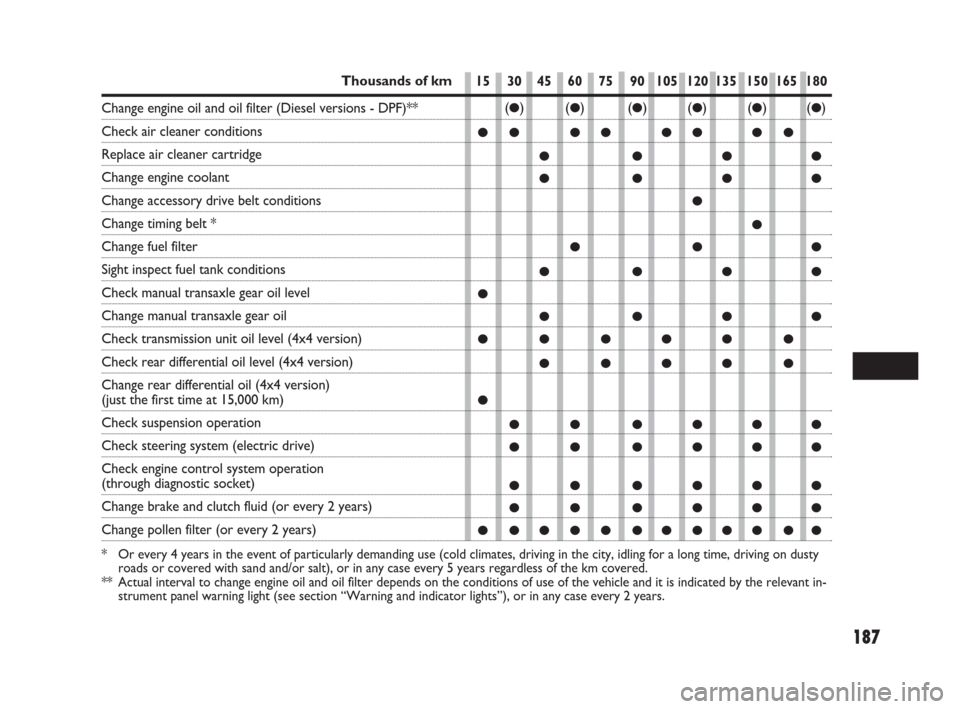
187
15 30 45 60 75 90 105 120 135 150 165 180
(●)(●)(●)(●)(●)(●)
●● ●● ●● ●●
●●●●
●●●●
●
●
●●●
●●●●
●
●●●●
●●●●●●
●●●●●
●
●● ●●●●
●● ●●●●
●● ●●●●
●● ●●●●
● ●●●● ●●●●●●●
Thousands of km
Change engine oil and oil filter (Diesel versions - DPF)**
Check air cleaner conditions
Replace air cleaner cartridge
Change engine coolant
Change accessory drive belt conditions
Change timing belt *
Change fuel filter
Sight inspect fuel tank conditions
Check manual transaxle gear oil level
Change manual transaxle gear oil
Check transmission unit oil level (4x4 version)
Check rear differential oil level (4x4 version)
Change rear differential oil (4x4 version)
(just the first time at 15,000 km)
Check suspension operation
Check steering system (electric drive)
Check engine control system operation
(through diagnostic socket)
Change brake and clutch fluid (or every 2 years)
Change pollen filter (or every 2 years)
* Or every 4 years in the event of particularly demanding use (cold climates, driving in the city, idling for a long time, driving on dusty
roads or covered with sand and/or salt), or in any case every 5 years regardless of the km covered.
** Actual interval to change engine oil and oil filter depends on the conditions of use of the vehicle and it is indicated by the relevant in-
strument panel warning light (see section “Warning and indicator lights”), or in any case every 2 years.
181-224 Fiat16 New GB 27-11-2007 11:29 Pagina 187
Page 218 of 266
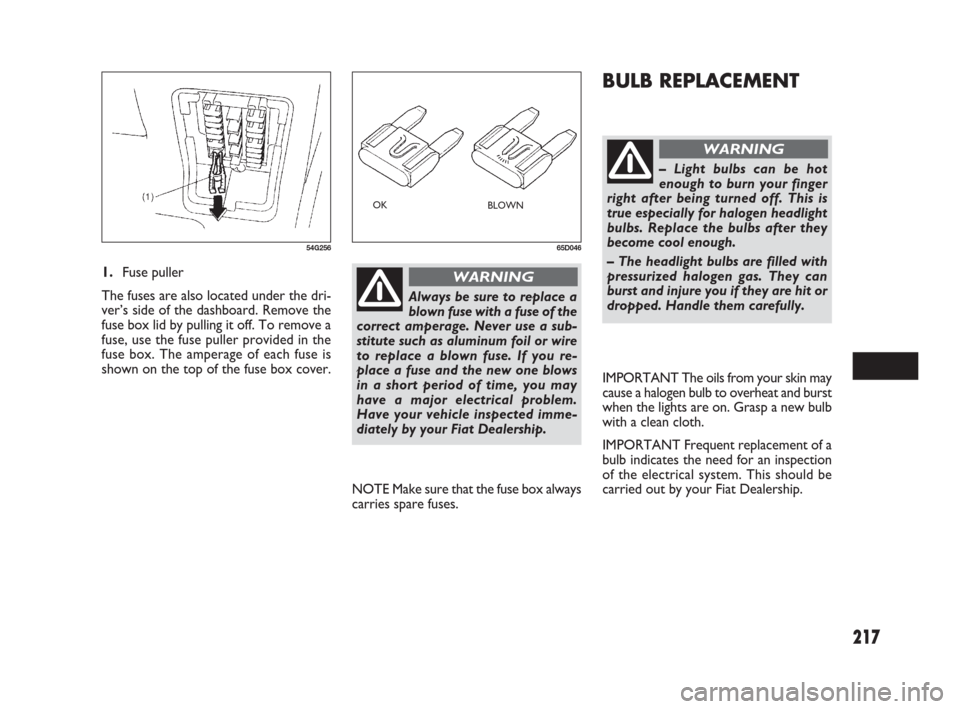
217
BULB REPLACEMENT
1.Fuse puller
The fuses are also located under the dri-
ver’s side of the dashboard. Remove the
fuse box lid by pulling it off. To remove a
fuse, use the fuse puller provided in the
fuse box. The amperage of each fuse is
shown on the top of the fuse box cover.
54G256
Always be sure to replace a
blown fuse with a fuse of the
correct amperage. Never use a sub-
stitute such as aluminum foil or wire
to replace a blown fuse. If you re-
place a fuse and the new one blows
in a short period of time, you may
have a major electrical problem.
Have your vehicle inspected imme-
diately by your Fiat Dealership.
WARNING
65D046
NOTE Make sure that the fuse box always
carries spare fuses.
OK
BLOWN
– Light bulbs can be hot
enough to burn your finger
right after being turned off. This is
true especially for halogen headlight
bulbs. Replace the bulbs after they
become cool enough.
– The headlight bulbs are filled with
pressurized halogen gas. They can
burst and injure you if they are hit or
dropped. Handle them carefully.
WARNING
IMPORTANT The oils from your skin may
cause a halogen bulb to overheat and burst
when the lights are on. Grasp a new bulb
with a clean cloth.
IMPORTANT Frequent replacement of a
bulb indicates the need for an inspection
of the electrical system. This should be
carried out by your Fiat Dealership.
181-224 Fiat16 New GB 27-11-2007 11:30 Pagina 217
Page 220 of 266
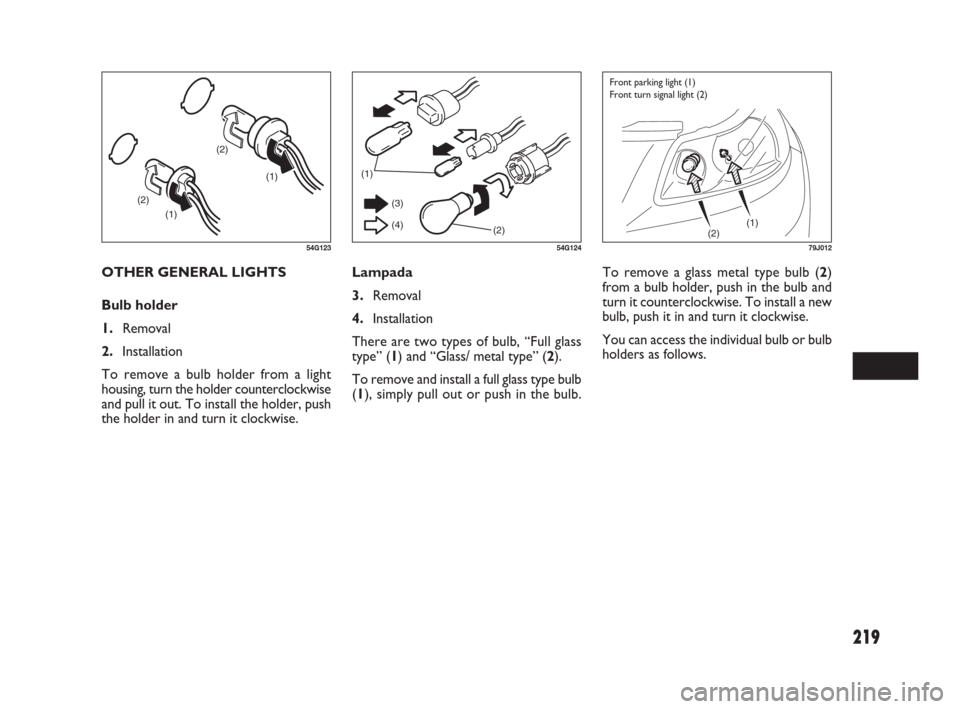
219
Lampada
3.Removal
4.Installation
There are two types of bulb, “Full glass
type” (1) and “Glass/ metal type” (2).
To remove and install a full glass type bulb
(1), simply pull out or push in the bulb. OTHER GENERAL LIGHTS
Bulb holder
1.Removal
2.Installation
To remove a bulb holder from a light
housing, turn the holder counterclockwise
and pull it out. To install the holder, push
the holder in and turn it clockwise.
(1)
(1) (2)(2)
54G123
(1)
(2) (3)
(4)
54G124
(1)
(2)
79J012
Front parking light (1)
Front turn signal light (2)
To remove a glass metal type bulb (2)
from a bulb holder, push in the bulb and
turn it counterclockwise. To install a new
bulb, push it in and turn it clockwise.
You can access the individual bulb or bulb
holders as follows.
181-224 Fiat16 New GB 27-11-2007 11:30 Pagina 219